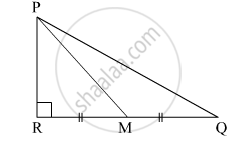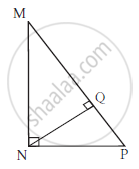Advertisements
Advertisements
प्रश्न
In an isosceles triangle, length of the congruent sides is 13 cm and its base is 10 cm. Find the distance between the vertex opposite the base and the centroid.
उत्तर
\[\text{Area of the triangle} = \sqrt{s\left( s - a \right)\left( s - b \right)\left( s - c \right)}\]
\[s = \frac{a + b + c}{2}\]
\[ = \frac{13 + 13 + 10}{2}\]
\[ = \frac{36}{2}\]
= 18 cm
\[\text{Area of the triangle} = \sqrt{18\left( 18 - 13 \right)\left( 18 - 13 \right)\left( 18 - 10 \right)}\]
\[ = \sqrt{2 \times 3 \times 3 \times 5 \times 5 \times 2 \times 2 \times 2}\]
= 60 sq.cm
\[\text{Also}, \]
\[\text{Area of the triangle} = \frac{1}{2} \times base \times height\]
\[ \Rightarrow 60 = \frac{1}{2} \times 10 \times \text{height}\]
\[ \Rightarrow \text{height} = \frac{60}{5}\]
= 12 cm
The centroid is located two third of the distance from any vertex of the triangle.
\[\therefore \text{Distance between the vertex and the centroid} = \frac{2}{3} \times 12 = 8 cm\]
APPEARS IN
संबंधित प्रश्न
Two towers of heights 10 m and 30 m stand on a plane ground. If the distance between their feet is 15 m, find the distance between their tops
ABCD is a rhombus. Prove that AB2 + BC2 + CD2 + DA2= AC2 + BD2
From a point O in the interior of a ∆ABC, perpendicular OD, OE and OF are drawn to the sides BC, CA and AB respectively. Prove
that :
`(i) AF^2 + BD^2 + CE^2 = OA^2 + OB^2 + OC^2 – OD^2 – OE^2 – OF^2`
`(ii) AF^2 + BD^2 + CE^2 = AE^2 + CD^2 + BF^2`
In a right triangle ABC right-angled at C, P and Q are the points on the sides CA and CB respectively, which divide these sides in the ratio 2 : 1. Prove that
`(i) 9 AQ^2 = 9 AC^2 + 4 BC^2`
`(ii) 9 BP^2 = 9 BC^2 + 4 AC^2`
`(iii) 9 (AQ^2 + BP^2 ) = 13 AB^2`
A guy wire attached to a vertical pole of height 18 m is 24 m long and has a stake attached to the other end. How far from the base of the pole should the stake be driven so that the wire will be taut?
PQR is a triangle right angled at P. If PQ = 10 cm and PR = 24 cm, find QR.
Identify, with reason, if the following is a Pythagorean triplet.
(24, 70, 74)
Find the side and perimeter of a square whose diagonal is 10 cm.
In the given figure, M is the midpoint of QR. ∠PRQ = 90°. Prove that, PQ2 = 4PM2 – 3PR2.


In ΔMNP, ∠MNP = 90˚, seg NQ ⊥ seg MP, MQ = 9, QP = 4, find NQ.
In ΔABC, Find the sides of the triangle, if:
- AB = ( x - 3 ) cm, BC = ( x + 4 ) cm and AC = ( x + 6 ) cm
- AB = x cm, BC = ( 4x + 4 ) cm and AC = ( 4x + 5) cm
ABC is a triangle, right-angled at B. M is a point on BC.
Prove that: AM2 + BC2 = AC2 + BM2
Prove that (1 + cot A - cosec A ) (1 + tan A + sec A) = 2
The sides of a certain triangle is given below. Find, which of them is right-triangle
16 cm, 20 cm, and 12 cm
Find the Pythagorean triplet from among the following set of numbers.
3, 4, 5
Find the Pythagorean triplet from among the following set of numbers.
2, 6, 7
Find the Pythagorean triplet from among the following set of numbers.
4, 7, 8
The sides of the triangle are given below. Find out which one is the right-angled triangle?
1.5, 1.6, 1.7
In triangle ABC, line I, is a perpendicular bisector of BC.
If BC = 12 cm, SM = 8 cm, find CS
If ΔABC ~ ΔPQR, `("ar" triangle "ABC")/("ar" triangle "PQR") = 9/4` and AB = 18 cm, then the length of PQ is ______.
